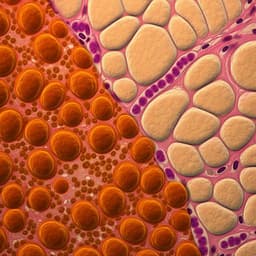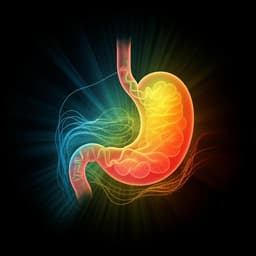
Medicine and Health
Perilipin 5 links mitochondrial uncoupled respiration in brown fat to healthy white fat remodeling and systemic glucose tolerance
V. I. Gallardo-montejano, C. Yang, et al.
This groundbreaking study reveals how Perilipin 5 (PLIN5) levels surge in brown adipose tissue (BAT) during cold exposure, leading to enhanced fatty acid uptake and mitochondrial function. Conducted by renowned researchers including Violeta I. Gallardo-Montejano and Chaofeng Yang, the findings suggest that targeting PLIN5 could offer new therapeutic avenues for combating metabolic diseases.
~3 min • Beginner • English
Introduction
Brown adipose tissue (BAT) generates heat during cold exposure via UCP1-mediated mitochondrial uncoupling and is linked to systemic improvements in glucose tolerance and insulin sensitivity. Understanding how thermogenic mitochondrial capacity is regulated in adipocytes remains an open question. Perilipin 5 (PLIN5), a lipid droplet protein enriched in oxidative tissues and highly expressed in BAT, has been implicated in lipid storage, lipolysis regulation through interactions with ATGL/ABHD5, lipid droplet–mitochondria interactions, and transcriptional control of mitochondrial biogenesis via PGC1α/SIRT1. Human and mouse data associate PLIN5 expression with favorable metabolic traits and insulin sensitivity. The authors hypothesized that PLIN5 in BAT augments mitochondrial respiratory and thermogenic capacity during increased metabolic demand (e.g., cold exposure) and that modulating PLIN5 would impact systemic metabolism.
Literature Review
Prior studies established thermogenic adipose tissue activity in adult humans and its potential as a target for metabolic diseases. BAT activation increases uptake of glucose and fatty acids and improves systemic insulin sensitivity. PLIN5 overexpression in cells increases TAG storage and fatty acid oxidation and modulates lipolysis through interactions with ATGL and ABHD5; PLIN5 localizes to mitochondria and may promote LD–mitochondria contacts. Mouse models suggest PLIN5 influences systemic metabolism; whole-body PLIN5 knockout mice are insulin resistant due to reduced glucose disposal in muscle and WAT. In humans, adipose PLIN5 expression correlates positively with insulin sensitivity and favorable metabolic traits. Prior in vitro work showed nuclear PLIN5 forms complexes with PGC1α and promotes transcription of mitochondrial genes, and PLIN5 silencing in BAT cells reduces respiration and thermogenic gene expression. However, in vivo roles of PLIN5 specifically in BAT or WAT were previously undefined.
Methodology
- Animal models: Male C57BL/6J mice. Generated BAT-specific, doxycycline-inducible PLIN5 overexpression mice (BATIPLIN5; TRE-Plin5 crossed with UCP1rtTA) and BAT-specific PLIN5 knockout mice (BKOPLIN5; Plin5loxP/loxP crossed with UCP1-Cre). Created UCP1-deficient background crossed with BATIPLIN5 (UCP1KO/BATIPLIN5). Controls matched by genotype background and DOX diet where applicable.
- Environmental conditions: Housing at 30 °C (thermoneutral), 23 °C (room temperature), or 6 °C (cold) for specified durations; acute cold tolerance tests with fasting; chronic cold acclimation with food.
- Induction and validation: DOX diets (200 mg/kg) to induce TRE-Plin5. qPCR and Western blot to confirm tissue-specific PLIN5 overexpression or knockout; time-course of PLIN5 induction during cold.
- Metabolic phenotyping: Body weight, body composition (NMR), food intake, indirect calorimetry, OGTT (2.5 g/kg), ITT (1 U/kg), random/fed glucose measurements, pyruvate tolerance test.
- Lipid metabolism assays: Serum triglycerides and NEFA (fasted/fed, various temperatures). Oral olive oil lipid tolerance. Radiolabeled triolein (3H) IV to assess triglyceride clearance, tissue fatty acid uptake and oxidation. Ex vivo lipolysis of BAT and iWAT explants (basal and CL-316,243-stimulated). Gene expression of lipid handling (Cd36, Lpl, Angptl4, Fatp1) and de novo lipogenesis genes (Acss2, Acaca, Fasn, Chrebp).
- Histology and EM: H&E for BAT and iWAT morphology and adipocyte sizing; Oil Red O for hepatic steatosis. Transmission EM to quantify mitochondrial cristae packing (total cristae length/mitochondrial area), mitochondria size/aspect ratio, and LD–mitochondria contacts.
- Mitochondrial function: Mitochondrial DNA content (COX2/rps18). BAT citrate synthase activity. Seahorse XFp OCR in isolated BAT mitochondria with pyruvate/malate substrates and GDP to inhibit UCP1.
- Signaling assays: Insulin-stimulated AKT phosphorylation (pAKT S473/AKT) in iWAT and liver; Glut4 mRNA expression in iWAT.
- Pharmacological interventions: ATGL inhibitor Atglistatin (200 µmol/kg/day PO, 7 days) to test lipolysis contribution; SIRT1 inhibitor EX-527 (10 mg/kg/day IP, 7 days). SIRT1 deacetylase activity measured in BAT nuclear extracts.
- Statistics: Student’s t test or ANOVA with Tukey post hoc; p < 0.05 considered significant.
Key Findings
- PLIN5 induction by cold/β3-agonist in BAT: Plin5 mRNA increased ~3-fold at 6 °C vs 30 °C and ~2-fold vs 23 °C after 16 h; PLIN5 protein rose with decreasing temperature and peaked at 48 h of 6 °C exposure, ~40-fold higher than after 7 days at 30 °C. CL-316,243 (β3-agonist) for 2–7 days similarly increased PLIN5.
- BAT-specific PLIN5 overexpression (BATIPLIN5): ~10-fold Plin5 mRNA and ~4.5-fold PLIN5 protein increase in BAT at 23 °C; no induction in other tissues.
- Glucose homeostasis: BATIPLIN5 mice showed improved OGTT with lower insulin on HFD and chow; enhanced insulin tolerance. At 6 °C, despite higher food intake, BATIPLIN5 lost more weight and had lower random blood glucose; no blood glucose difference at 23/30 °C.
- Cold tolerance: During acute cold (fasted), body temperature divergence at 8 h with BATIPLIN5 higher; during chronic cold (fed), BATIPLIN5 maintained higher core temperature on days 2, 4, 14, 21; during acclimation fasting (day 22), higher temperatures from 5 h onward. BAT thermogenic gene expression (e.g., Ucp1, Ppargc1a, Elovl3, Dio2, Cidea, Prdm16, Tfam, Glut4, Fgf21) increased in BATIPLIN5 vs controls at 23 °C and further at 6 °C (gene-specific).
- BAT lipid handling: BATIPLIN5 BAT displayed smaller lipid droplets at 23 °C and 6 °C; BAT TAG content greater after overnight 6 °C without weight change; ex vivo BAT lipolysis (basal and β3-stimulated) unchanged. Trends toward lower NEFA; improved triglyceride clearance after olive oil gavage; increased radiolabeled triolein clearance; elevated fatty acid uptake and oxidation in BAT. Lpl expression increased significantly in BAT after cold in BATIPLIN5 vs controls; glucose uptake into BAT not increased.
- De novo lipogenesis: At 23 °C, increased Acss2 and Acaca expression (with trends for Fasn and Chrebp) in BATIPLIN5; differences not observed after acute cold.
- iWAT remodeling: Smaller adipocytes at 23 °C (more pronounced at 6 °C); decreased beiging gene expression (e.g., Ucp1 and others) despite cold; markers of sympathetic innervation (Th, Dbh) increased with cold similarly between genotypes; inflammatory genes Saa3 and Mcp1 reduced; increased insulin signaling (higher insulin-stimulated pAKT S473) and higher Glut4 mRNA; β3-stimulated ex vivo lipolysis increased. No serum FGF21 differences.
- Liver: BATIPLIN5 protected from HFD-induced hepatic steatosis (Oil Red O, H&E, and biochemical TAG reductions); increased hepatic insulin-stimulated pAKT S473; reduced glycemia during pyruvate tolerance, suggesting lower gluconeogenesis.
- Mitochondrial structure/function: EM showed increased cristae packing in BATIPLIN5 at 23 °C to a level comparable to control at 6 °C; citrate synthase activity increased; isolated BAT mitochondria exhibited higher substrate-driven OCR; GDP inhibition reduced OCR in BATIPLIN5 below control, indicating UCP1-dependent increase. LD–mitochondria contacts decreased with cold in both genotypes; at 23 °C, BATIPLIN5 had fewer contacts and smaller mitochondrial area, consistent with a more oxidative cytoplasmic mitochondrial phenotype.
- Dependence on UCP1: In UCP1KO/BATIPLIN5 mice, improved glucose tolerance and iWAT adipocyte size reduction seen in BATIPLIN5 were lost. UCP1KO background eliminated BATIPLIN5 metabolic benefits.
- Role of ATGL and SIRT1: BAT nuclear SIRT1 activity elevated in BATIPLIN5; EX-527 reduced SIRT1 activity; Atglistatin reduced ex vivo BAT lipolysis. Both Atglistatin and EX-527 attenuated the BATIPLIN5-associated increase in cristae packing and increased mitochondrial area, implicating conserved ATGL-SIRT1 pathways.
- BAT-specific PLIN5 knockout (BKOPLIN5): PLIN5 deleted only in BAT. BAT showed marked reduction in lipid droplets, reduced Ucp1 and Ppargc1a expression at 23 °C and 6 °C; at 6 °C, decreased cristae packing and altered cristae morphology; isolated BAT mitochondrial OCR reduced. Systemically, slight OGTT impairment at 60 min on chow, none on HFD; no weight or acute cold tolerance difference. iWAT compensation: increased Ucp1 and Ppargc1a expression after 16 h at 6 °C, suggesting beiging compensates for BAT deficiency.
Discussion
The study demonstrates that PLIN5 is a cold-inducible regulator in BAT that enhances mitochondrial cristae architecture and uncoupled respiration, thereby augmenting thermogenic capacity. BAT-specific PLIN5 overexpression mimicked cold-induced mitochondrial remodeling and improved systemic metabolism, including glucose tolerance, insulin sensitivity, and hepatic steatosis resistance, accompanied by healthy iWAT remodeling with smaller adipocytes, lower inflammation, and improved insulin signaling. Increased fatty acid uptake and oxidation in BAT, improved triglyceride clearance, and selective upregulation of Lpl under cold suggest that PLIN5 facilitates BAT usage of circulating lipids as fuel. The improvements require UCP1, indicating dependence on uncoupled respiration and/or intact mitochondrial function. Pharmacological inhibition implicates ATGL-dependent lipolysis and SIRT1 activity in mediating PLIN5’s effects on mitochondrial cristae. Conversely, loss of PLIN5 in BAT impairs cold-induced cristae packing and mitochondrial respiration but systemic glucose and cold tolerance are preserved via iWAT compensation (enhanced thermogenic gene expression). These findings support a model where BAT acts as a metabolic sink for fatty acids, with PLIN5 orchestrating mitochondrial adaptations that influence whole-body metabolism.
Conclusion
This work identifies PLIN5 as a key modulator of BAT mitochondrial structure and function during cold stress, sufficient to increase fatty acid uptake/oxidation and UCP1-dependent respiration, and to drive beneficial systemic metabolic effects including improved glucose tolerance, enhanced iWAT insulin sensitivity with smaller adipocytes, and protection from diet-induced hepatic steatosis. The benefits of PLIN5 overexpression depend on UCP1 and are mediated in part through ATGL and SIRT1 pathways. BAT-specific deletion of Plin5 reveals its necessity for maintaining mitochondrial cristae architecture and respiration during cold, with compensatory beiging responses in iWAT sustaining systemic tolerance. Potential future research directions include: identifying BAT-derived factors driving iWAT remodeling and potential hyperplasia; directly testing whether iWAT hyperplasia underlies smaller adipocytes; elucidating the extent of direct PLIN5–mitochondria interactions; and developing strategies to safely and specifically enhance PLIN5 in human thermogenic adipose tissue, alone or in combination with cold or pharmacologic stimuli.
Limitations
- The mechanistic link between enhanced BAT PLIN5 and reduced iWAT adipocyte size/increased insulin sensitivity is unresolved; not attributable to iWAT beiging or elevated FGF21.
- The study did not directly demonstrate whether smaller iWAT adipocytes arise from adipocyte hyperplasia versus reduced hypertrophy.
- While data support SIRT1/PGC1α involvement, a direct role of PLIN5 via physical association with mitochondria has not been excluded.
- Systemic ATGL inhibition effects cannot distinguish tissue-specific contributions (e.g., WAT vs BAT) to altered cristae packing.
- Experiments were conducted in male C57BL/6J mice; sex- and strain-specific effects were not assessed.
Related Publications
Explore these studies to deepen your understanding of the subject.







